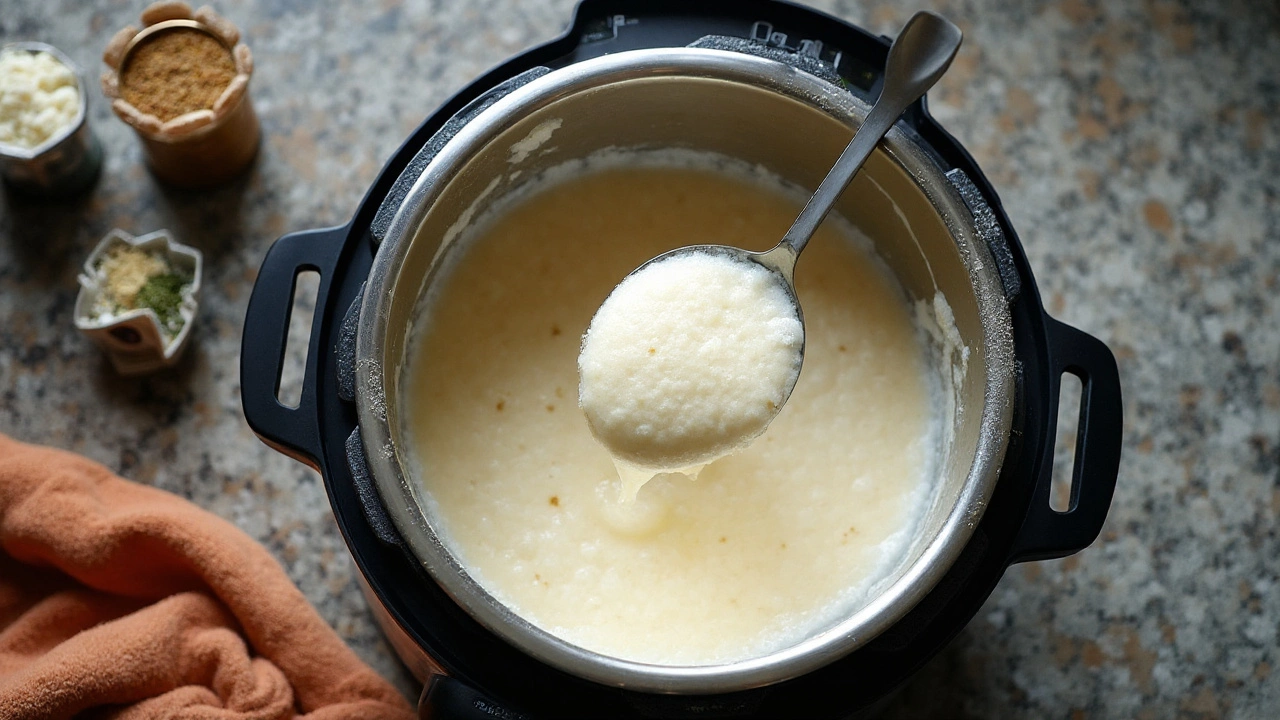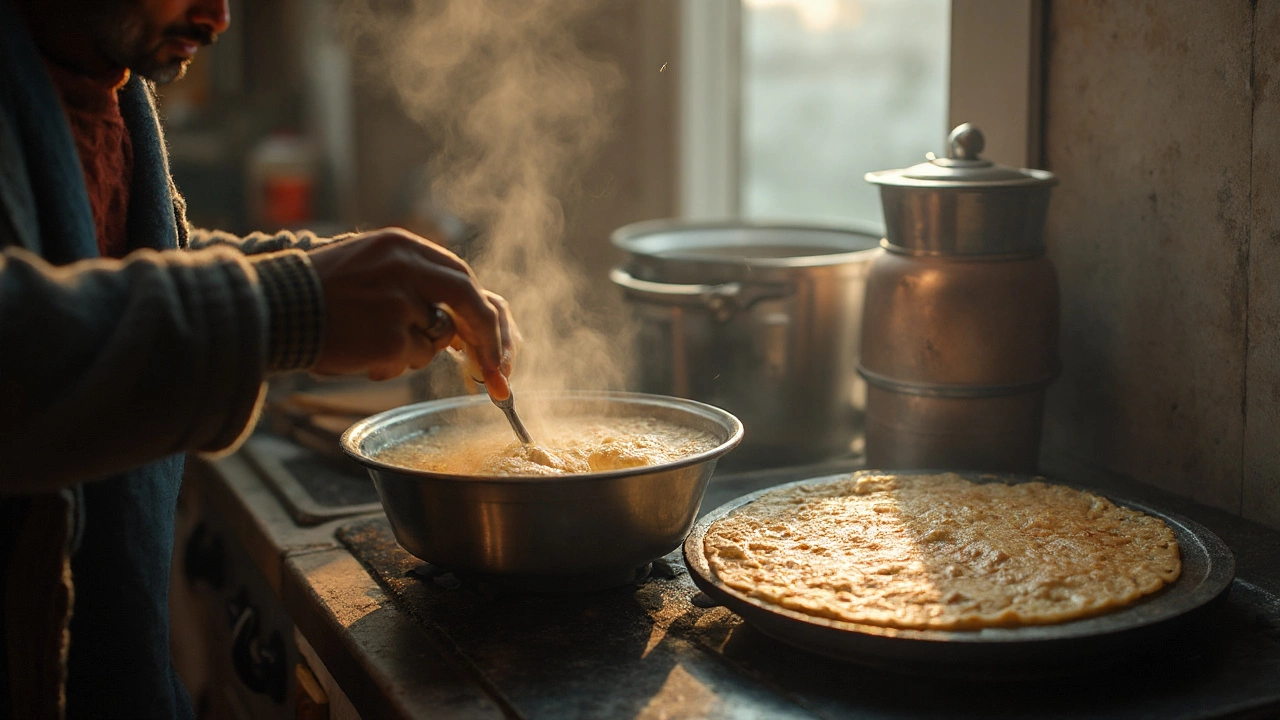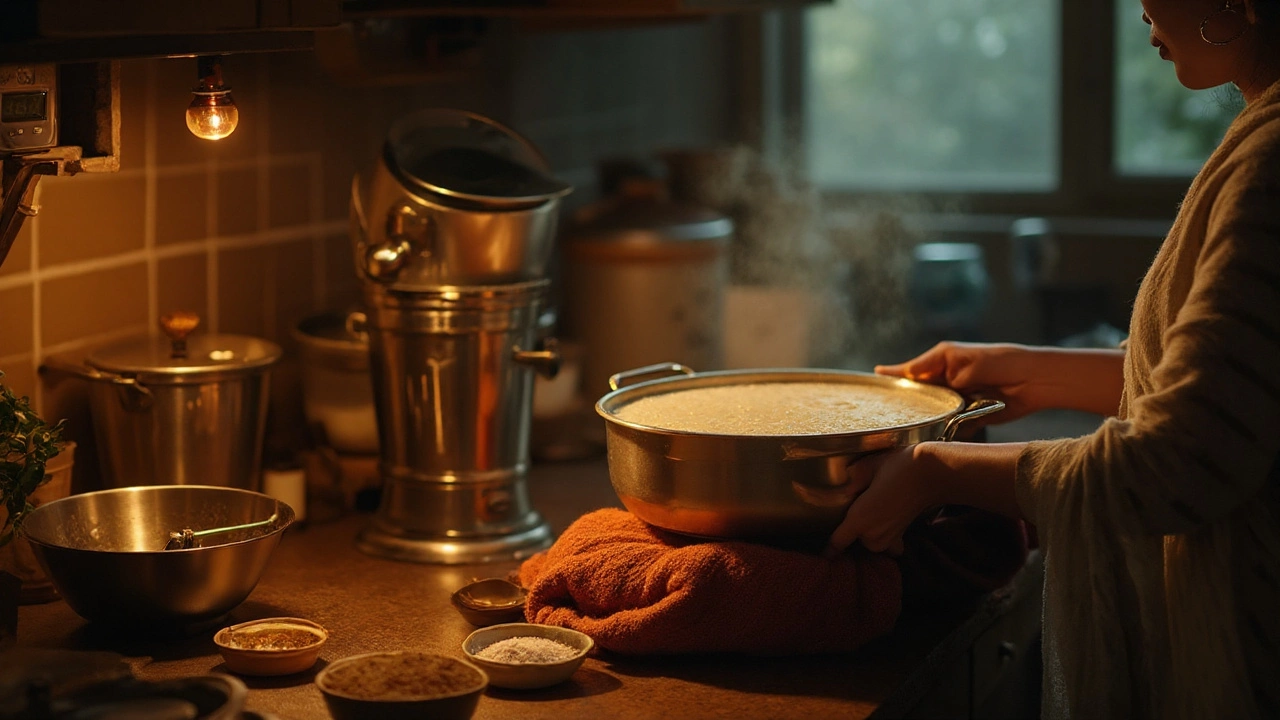You want crisp, lacy dosas tonight, not tomorrow-and no yeast. The good news: real fermentation can be fast if you control temperature, hydration, and the microbes already on your dal and rice. In Auckland’s chilly evenings, I’ve still pulled off a bubbly batter before bedtime using the oven light and a warm water bath while Nisha set the table and Rohan guarded the tawa. Expect 6-8 hours in warm conditions, 8-12 hours if it’s cool-faster if you seed the batter with a little starter from your last batch. No shortcuts that kill flavor, just a smarter process.
TL;DR - The Fastest No-Yeast Plan
Here’s the short version that gets you from soaked grains to ready-to-pour batter, without compromising that classic tang and lift.
- Use a high-activity dal + smart starch: good-quality whole urad (gota) + parboiled/idli rice + a little poha (or cooked rice) + 0.5-1% fenugreek (methi) seeds.
- Soak and grind warm (not hot): aim for 30-35°C soaking water; keep grinding water cool to protect fluff.
- Salt before fermenting (about 1-1.5% by total weight) and whip air into the batter at the end for 1-2 minutes.
- Incubate warm: 30-32°C is the sweet spot. Use the oven light, Instant Pot Yogurt mode, or a hot-water-bottle setup. Mark the starting level.
- Starter = speed: add 2 tablespoons of yesterday’s batter (best), or 1 tablespoon plain yogurt whey for a dairy-optional boost. Still no commercial yeast.
- Ready when doubled and bubbly, with a clean, tangy aroma. If it smells boozy or looks pink/orange, discard.
Want the one phrase that unlocks dinner? Keep everything warm and slightly thick, and you’ll ferment dosa batter quickly without yeast-and without losing that dosa soul.
Step-by-Step: Fast Fermentation Without Yeast (Home Kitchen or Instant Pot)
This is my reliable, weeknight-friendly method. It works in humid summers and stubborn winters (hello, Auckland), and it scales up or down without drama.
Ingredients (makes ~1.6-1.8 kg batter; 18-22 dosas)
- Urad dal (whole or split, unpolished preferred): 300 g (about 1.5 cups)
- Parboiled/idli rice (or a mix of idli rice + raw rice): 750 g (about 4 cups)
- Flattened rice (poha) or cooked rice: 50 g poha (about 1/2 cup) OR 3 tablespoons cooked rice
- Fenugreek (methi) seeds: 3 g (about 1/2 teaspoon)
- Non-iodized salt (rock/kosher): 12-18 g (about 2-3 teaspoons), to taste
- Water: 1.0-1.3 liters, as needed
- Optional starter for speed: 2 tablespoons previous fermented dosa/idli batter OR 1 tablespoon plain yogurt whey (dairy-free? skip the whey)
Ratios that help speed
- Urad : Rice = 1 : 2.5 to 1 : 3 by weight for dosa (more urad gives lift; more rice gives crispness)
- Poha at 5-7% of total rice weight shortens time and adds lacey edges
- Methi 0.5-1% of urad weight improves viscosity, foam, and microbial growth
1) Sort, rinse, soak (3-5 hours)
- Rinse urad and rice separately until water runs mostly clear. Add methi to the urad bowl.
- Soak urad+methi in warm water at ~35°C; soak rice and poha (or reserve poha to add during grinding) in warm water too. Warm water speeds hydration and gives microbes a head start.
- Cold climate trick: pop the soaking bowls in the oven with only the light on, door closed.
2) Grind for aeration and structure
- Drain urad. Grind with minimal cold water to a very fluffy, light batter. You want soft peaks when you lift the spoon. In a wet grinder this takes 20-30 minutes; in a high-speed blender, do short pulses with ice-cold water to prevent heating.
- Grind rice (and poha if not soaked with the rice) to a fine, slightly gritty paste. Dosas like a tiny bit of texture.
- Combine both. Add salt now (1-1.5% of total batter weight). Salt before fermenting helps control wild microbes and keeps the flavor clean.
- Whip the combined batter by hand for 1-2 minutes to fold in air. This kickstarts growth and gives you better lift.
3) Seed (optional, faster) and incubate warm
- Stir in 2 tablespoons of well-fermented leftover batter. If you don’t have it, 1 tablespoon plain yogurt whey is a decent booster. This is still yeast-free in the commercial sense.
- Transfer to a tall, wide container with extra headroom. Mark the level with tape or a rubber band.
- Incubate at 30-32°C. Your options:
- Oven light method: Place the bowl in the oven with the light on. If your oven runs cool, add a bowl of hot water (not boiling) to stabilize warmth.
- Instant Pot: Yogurt mode - “Less” or “Normal” for 6-10 hours, vent closed, lid on. Use a glass bowl on the trivet if you like.
- Microwave cabinet: Put a mug of very hot water next to the batter; close the door. Replace water every 2-3 hours.
- Cooler + hot water bottle: Put the bowl in an insulated cooler with a wrapped hot water bottle. Works even on frosty Auckland nights.
4) When is it ready?
- Volume: 1.5-2× rise with a domed top and a constellation of small bubbles.
- Aroma: gentle tang, not sharp, not boozy.
- Texture: scoopable, not runny; it should slowly plop off a ladle.
Gently stir once to even the batter, then refrigerate within 30 minutes if you’re not making dosas right away. It will continue to mature slowly in the fridge.
5) Cook for crisp, even browning
- Day 1 batter: slightly thicker, makes soft dosas with crisp edges. Day 2: thinner, extra crisp.
- Pan: cast iron or thick nonstick, medium-high heat. Wipe with a split onion dipped in oil to season between batches.
- Spread batter thin in circles, drizzle a few drops of oil/ghee, cook until golden. Flip only if you like it browned on both sides.
Note on science: CFTRI food scientists (Mysuru) and multiple Indian culinary schools cite 30-32°C as the practical sweet spot where lactic acid bacteria and native yeasts from dal/rice thrive in idli/dosa batters. Below 24°C, things slow down fast; above ~40°C, fermentation stalls.
| Ambient/Incubator Temp | Typical Fermentation Time | What to Expect | Best Method |
|---|---|---|---|
| 32-34°C | 6-8 hours | Strong rise, fine bubbles, mild tang | Instant Pot Yogurt, oven light + hot water |
| 28-30°C | 8-12 hours | Good rise; ideal flavor if you prefer a little more tang | Oven light, warm corner of kitchen |
| 24-26°C | 12-16 hours | Slower rise; check at 12 h | Microwave + hot water mug |
| 20-22°C | 16-24 hours | Might need a starter; risk of flat flavor | Cooler + hot water bottle |
| 16-18°C | 24-36 hours | Unreliable without active warming | Instant Pot recommended |
Rules of thumb
- Every 5°C drop roughly doubles fermentation time.
- Thicker batter ferments faster than thin.
- Fresh urad ferments faster than old, polished, or bleached dal.

Smart Shortcuts (Still Yeast-Free): Starters, Grains, Heat Hacks
You don’t need commercial yeast to go fast; you just need more friendly microbes and the right “food” for them. Here are the boosters I use when dinner plans change at 4 pm.
1) Natural starters you already have
- Yesterday’s idli/dosa batter: 2 tablespoons per kilo of fresh batter cuts time by 20-40%.
- Yogurt whey: 1 tablespoon per kilo-handy, clean flavor. Vegan? Skip.
- Fermented rice water (kanji): use 2-3 tablespoons if you regularly keep it.
These are all traditional, and they won’t give you a yeasty aftertaste.
2) Grains and add-ins that speed things up
- Poha or cooked rice: 5-7% of rice weight makes the batter more fermentable and helps crispness.
- Methi seeds: natural emulsifier; improves foam stability and rise.
- Urad quality: whole unpolished urad (gota) beats highly polished split urad for lift.
3) Heat without hotspots
- Oven light + hot water bowl = stable 30-32°C without cooking the batter.
- Instant Pot Yogurt “Less/Normal” keeps it in a safe range and is hands-off.
- Microwave caveat: never run the microwave; just use it as a warm box with a mug of hot water.
- Hot-water-bottle method: wrap the bottle in a towel and place beside (not under) the container inside a cooler. Replace when it cools.
4) Water and salt matter
- Chlorinated water can slow fermentation. If your tap water is highly chlorinated, let it sit 30 minutes or use filtered water.
- Aim for 1-1.5% salt by total batter weight. Too much salt slows things down; too little risks off flavors.
5) Aeration: the free boost
- Grind urad fluffy, and beat the finished batter for 1-2 minutes. Oxygen helps the early growth phase.
- Use a wide, tall container rather than a narrow jar; microbes like the extra oxygen diffusion in the beginning.
What I do on a busy weekday
On a windy Auckland Tuesday, I’ll soak at lunch, grind at 5 pm, seed with 2 tablespoons of last week’s batter, and incubate in the Instant Pot. By 10:30 pm it’s puffed and perfect. I pop it in the fridge, and we’re flipping dosas straight after school pickup the next day.
Checklists, Ratios, and Real-World Examples
Short on time? Use these quick references so you don’t have to scroll back mid-cook with batter on your fingers.
Quick-prep checklist
- Fresh urad (sniff: should smell clean, not dusty), parboiled/idli rice, poha, methi
- Warm soaking water (about 35°C)
- Clean blender/wet grinder and wide container
- Non-iodized salt, filtered water if needed
- Starter: leftover batter or yogurt whey (optional)
- Incubator: oven light/Instant Pot/microwave + hot water
Perfectly fermented batter-signs checklist
- 1.5-2× rise, dome top, small craters
- Tangy aroma (think mild yogurt), no sharp alcohol or sulfur
- Holds shape on the ladle, slowly flows off
- When you drop a spoonful in water it may float (not mandatory, but a nice sign)
Common pitfalls and quick fixes
- Too thin batter: add 1-2 tablespoons rice flour and whisk; next time grind with less water.
- No rise: increase warmth, add 1-2 tablespoons starter, and give it 2-4 more hours.
- Over-sour: fold in fresh ground rice paste or a bit of wheat semolina, then refrigerate; cook dosas slightly thicker.
- Weird smell or color (pink/orange film): discard-don’t try to save it.
Example timelines
- Summer evening (28-30°C kitchen): Grind at 4 pm → Ready by 11 pm
- Spring/autumn (22-24°C): Grind at 5 pm → Oven light + hot water → Ready by 7 am
- Winter (16-18°C): Grind at 6 pm → Instant Pot Yogurt mode → Ready 8-10 am
Flavor control
- Mild tang: stop at 1.5× rise and refrigerate.
- Deeper tang: wait for a 2× rise and a slightly sharper aroma.
- If you prefer ultra-crisp dosas, use Day 2 batter thinned with a splash of water.
Ingredient swaps (that still work fast)
- No poha? Use 2-3 tablespoons cooked rice per kilo of batter.
- No idli rice? Use parboiled rice or a 50:50 mix of parboiled + raw short-grain rice. Basmati is not ideal.
- Gluten-free? This batter is naturally gluten-free.
- Vegan? Yes-just skip yogurt whey.
Make-ahead plan
- Ferment, then refrigerate up to 4-5 days. It will get tangier each day.
- Freezer: portion in zip bags; freeze up to 1 month. Thaw overnight in the fridge, stir, and adjust water before cooking.

Mini-FAQ and Troubleshooting (Cold Kitchens, Starters, and Safety)
Isn’t fermentation slow without yeast?
Not if you give native microbes the right conditions. Warmth (30-32°C), proper hydration, a bit of methi, and optional seeding with leftover batter will do the job in an evening.
Can I add baking soda or Eno for speed?
Those leaven chemically. They don’t ferment. Use only in emergencies when you must cook now; you’ll miss the complex flavor and lacy texture real fermentation brings.
Salt before or after fermenting?
Add before. A modest 1-1.5% by weight controls the microbial profile and leads to cleaner flavor. Too much salt will slow things down.
Why didn’t my batter rise?
Four likely reasons: it was too cold; the batter was too thin; urad was old/over-polished; or you didn’t whip air in. Fix by warming to 30-32°C, adding a tablespoon of starter, and giving it 2-4 more hours.
How warm is too warm?
Above ~40-42°C, fermentation stalls and the batter can sour harshly. If your incubator feels hot to the touch, it’s probably too hot.
What container should I use?
Glass or stainless steel with headroom for a 2× rise. Cover loosely-a plate or breathable lid works better than airtight.
Does iodized salt really matter?
In small amounts, it’s fine, but non-iodized salt is more predictable for fermentation. If your past batters underperformed, try switching.
Which rice gives the crispiest dosas?
Parboiled/idli rice is reliable. A 3:1 rice:urad ratio with 5-7% poha gives great crunch without delaying fermentation.
How do I fix over-fermented (too sour) batter?
Stir in fresh ground rice paste or rice flour to dilute acidity, then refrigerate. Cook dosas on medium heat to prevent burning.
Can I use the same method for idli?
Yes, but keep the batter thicker and aim for a 2× rise with a smooth, cloud-like batter. Idlis are more sensitive to over-sourness.
Is this safe for kids?
Yes-this is natural lactic fermentation. Keep clean tools, avoid extreme heat, and toss any batter with off colors or smells.
My oven light is too hot/cold. Now what?
Use the cooler + hot-water-bottle trick, or Instant Pot Yogurt mode. In a pinch, the microwave-with-hot-water method stabilizes at friendly temps.
Real-life cold-weather plan (Auckland winter)
I use the Instant Pot Yogurt mode for 8-10 hours. If I’m out, I set the bowl inside a cooler with a hot water bottle wrapped in a tea towel. It stays warm and consistent, and the batter is ready by breakfast.
Final cooking tip
If the first dosa sticks, the pan is either too cool or too smooth. Heat a bit more, wipe with a tiny bit of oil, then rub with a cut onion. Works like magic.
Why this works: Warmer incubation, balanced hydration, a small percentage of methi and poha, and optional natural starters align with what food science labs in India have documented for idli/dosa fermentation: encourage lactic bacteria and native yeasts at ~30-32°C, keep batter moderately thick, and avoid chlorine/iodine stressors. It’s traditional craft, just made consistent.
If you try this tonight, tag your moment: the soft dome, the tiny bubbles, the way the ladle swirls into perfect circles on a hot tawa. That’s dinner without waiting till tomorrow.
